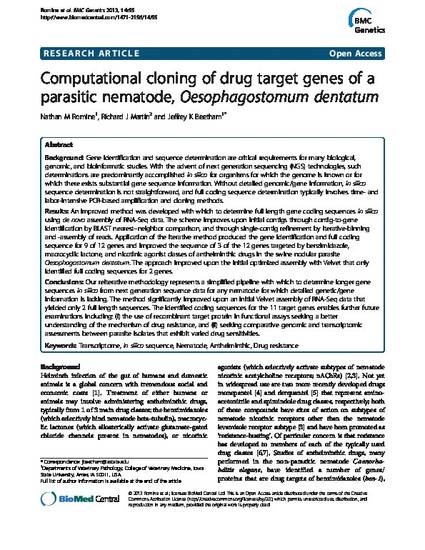
Article
Computational cloning of drug target genes of a parasitic nematode, Oesophagostomum dentatum
BMC Genetics
Document Type
Article
Disciplines
Publication Date
6-18-2013
DOI
10.1186/1471-2156-14-55
Abstract
Background: Gene identification and sequence determination are critical requirements for many biological, genomic, and bioinformatic studies. With the advent of next generation sequencing (NGS) technologies, such determinations are predominantly accomplished in silico for organisms for which the genome is known or for which there exists substantial gene sequence information. Without detailed genomic/gene information, in silico sequence determination is not straightforward, and full coding sequence determination typically involves time- and labor-intensive PCR-based amplification and cloning methods.
Results: An improved method was developed with which to determine full length gene coding sequences in silico using de novo assembly of RNA-Seq data. The scheme improves upon initial contigs through contig-to-gene identification by BLAST nearest–neighbor comparison, and through single-contig refinement by iterative-binning and -assembly of reads. Application of the iterative method produced the gene identification and full coding sequence for 9 of 12 genes and improved the sequence of 3 of the 12 genes targeted by benzimidazole, macrocyclic lactone, and nicotinic agonist classes of anthelminthic drugs in the swine nodular parasite Oesophagostomum dentatum. The approach improved upon the initial optimized assembly with Velvet that only identified full coding sequences for 2 genes.
Conclusions: Our reiterative methodology represents a simplified pipeline with which to determine longer gene sequences in silico from next generation sequence data for any nematode for which detailed genetic/gene information is lacking. The method significantly improved upon an initial Velvet assembly of RNA-Seq data that yielded only 2 full length sequences. The identified coding sequences for the 11 target genes enables further future examinations including: (i) the use of recombinant target protein in functional assays seeking a better understanding of the mechanism of drug resistance, and (ii) seeking comparative genomic and transcriptomic assessments between parasite isolates that exhibit varied drug sensitivities.
Rights
This is an Open Access article distributed under the terms of the Creative Commons Attribution License (http://creativecommons.org/licenses/by/2.0), which permits unrestricted use, distribution, and reproduction in any medium, provided the original work is properly cited.
Copyright Owner
Romine et al
Copyright Date
2013
Language
en
File Format
application/pdf
Citation Information
Nathan M. Romine, Richard J. Martin and Jeffrey K. Beetham. "Computational cloning of drug target genes of a parasitic nematode, Oesophagostomum dentatum" BMC Genetics Vol. 14 (2013) p. 55 Available at: http://works.bepress.com/jeffrey_beetham/4/

This article is from BMC Genetics 14 (2013): 55, doi:10.1186/1471-2156-14-55.